Book of Marvels
Wednesday, September 27, 2006
Pondering Dog Anxiety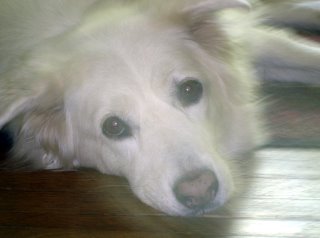
People in my neighborhood are already beginning their Halloween displays. On our morning walk, we saw a window covered in faux spiderwebs, a cluster of small pumpkins, and --most impressive of all--a stoutly stuffed scarecrow with a stake where the head should be. Lulu felt that this thing was not to be trusted. She paced back and forth at the end of her leash, sniffing the air. She cringed. Her tail--an extravagant plumed affair--slumped between her hind legs. She demanded a quick skulk-away.
We go through this every year during the holiday spectacle season. She cares not for the scarecrows or the ghosts that people dangle from trees and front porches; she shudders at those huge, bobbling, inflated snowmen of recent vintage; she cringes again in spring when the holiday exhibitionists drag their hot-air machines back outside and inflate giant Easter bunnies.
She is also so fearful during thunderstorms and in the weeks around Fourth of July that I'm thinking of getting her some doggie valium. I know these fears are common among dogs, but I don't really understand why SHE has them. I've had her since she was a puppy, and I know she wasn't fearful in her first couple of years. She's led an exceptionally pampered life--no children in the neighborhood have tormented her for sport, she hasn't been menaced by guns, she's had no near misses with cars. She never even experienced the rolled-newspaper discipline that was common for the dogs of my youth. I did once smack her on the nose when she drew blood with those puppy teeth, but her mother would have done the same.
Since these fears haven't been caused by experience, I wonder if they're part of her genetic package-- if the instinct to fear certain things is hardwired. Further, I wonder if she's programmed to fear them at a certain time in her life. I've wondered this kind of thing before, when I was writing an article for New Scientist about twin studies. These studies revealed that all sorts of things are present in our genes-- not only a propensity for colon cancer or obesity, but for religiosity and political conservatism. I asked one of the scientists if our genes are programmed to turn on at various times in our lives. Maybe in your twenties, your dissolute grandfather's genes lead you to max out your credit cards; in your thirties, your mother's frugal genes turn on and you finally manage to stick to a budget; then in your forties, you have enough leisure time (the influence of environment!) to take clarinet lessons (the genetic impulse passed on by your father's mother).
I'm sure that this scenario is simple-minded enough to make anyone who really knows much about science flinch, but still-- I like the idea of all these genetic possibilities coming into play at various times in my life, nudged by whatever's going on in my real world. Just as long as I don't start quivering under the dining room table during thunderstorms.

People in my neighborhood are already beginning their Halloween displays. On our morning walk, we saw a window covered in faux spiderwebs, a cluster of small pumpkins, and --most impressive of all--a stoutly stuffed scarecrow with a stake where the head should be. Lulu felt that this thing was not to be trusted. She paced back and forth at the end of her leash, sniffing the air. She cringed. Her tail--an extravagant plumed affair--slumped between her hind legs. She demanded a quick skulk-away.
We go through this every year during the holiday spectacle season. She cares not for the scarecrows or the ghosts that people dangle from trees and front porches; she shudders at those huge, bobbling, inflated snowmen of recent vintage; she cringes again in spring when the holiday exhibitionists drag their hot-air machines back outside and inflate giant Easter bunnies.
She is also so fearful during thunderstorms and in the weeks around Fourth of July that I'm thinking of getting her some doggie valium. I know these fears are common among dogs, but I don't really understand why SHE has them. I've had her since she was a puppy, and I know she wasn't fearful in her first couple of years. She's led an exceptionally pampered life--no children in the neighborhood have tormented her for sport, she hasn't been menaced by guns, she's had no near misses with cars. She never even experienced the rolled-newspaper discipline that was common for the dogs of my youth. I did once smack her on the nose when she drew blood with those puppy teeth, but her mother would have done the same.
Since these fears haven't been caused by experience, I wonder if they're part of her genetic package-- if the instinct to fear certain things is hardwired. Further, I wonder if she's programmed to fear them at a certain time in her life. I've wondered this kind of thing before, when I was writing an article for New Scientist about twin studies. These studies revealed that all sorts of things are present in our genes-- not only a propensity for colon cancer or obesity, but for religiosity and political conservatism. I asked one of the scientists if our genes are programmed to turn on at various times in our lives. Maybe in your twenties, your dissolute grandfather's genes lead you to max out your credit cards; in your thirties, your mother's frugal genes turn on and you finally manage to stick to a budget; then in your forties, you have enough leisure time (the influence of environment!) to take clarinet lessons (the genetic impulse passed on by your father's mother).
I'm sure that this scenario is simple-minded enough to make anyone who really knows much about science flinch, but still-- I like the idea of all these genetic possibilities coming into play at various times in my life, nudged by whatever's going on in my real world. Just as long as I don't start quivering under the dining room table during thunderstorms.

Saturday, September 23, 2006
Sunset over the apricots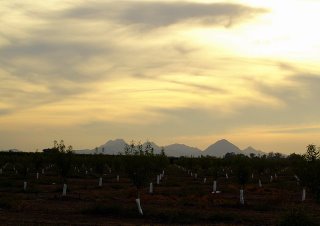
Or maybe they were young almond trees, or plums. I'm just guessing. My father would have known. The white wrappings at the bottom of the trees--which look like grave markings in this picture, or it could be my mood--are something that the growers do to prevent disease, I think.
I took this picture just as I was leaving my hometown--Oroville, CA--on a trip to gather information for an article about olive oil.
I love going back to Oroville, but it's always weird. I haven't lived there in decades, and it's amazing how dramatically small towns can change. Throw up a WalMart and a Home Depot, and acres of quotidian landmarks--tacky motels from the 50s, the restaurant where you used to eat fried chicken, the place where your mother took the dry cleaning, the nursery where you could hardly walk down the graveled path because so many tiny frogs were leaping from the plants, the other places you don't quite recall but know something else was there--are gone. As I drove around, I found myself trying to fit the map of before onto the map of now. In some areas, it was really quite impossible.
Those are the Buttes looming in the background of the picture, scruffy little peaks that rise sharply out of the Sacramento Valley. I always watched them dreamily as we drove away from Oroville when I was a kid. There still don't seem to be any major roads in or out of town, at least not for more than a couple of hundred feet; I like this, although maybe I wouldn't if I still lived there. My father (and now my sister, carrying his navigational genes intact) always chose the tiniest roads, anyway--barely paved roads that wound through the rice fields, past the avenues of elder olives, past the new orchards of almonds and plum and apricot. He always knew what they were, although they all looked the same to me. I'd look over the lushness at the Buttes, so enticingly harsh and uncultivated, and vow that I'd climb up there someday. I told my sister that and she told me that everyone says they're full of rattlesnakes. But it seemed that all of Oroville was full of rattlesnakes when I was a kid. Everyone had a rattlesnake encounter story.
I'm suffering a fictional malaise. The main character in my novel has a bad knee, and I seem to have caught it from her. I went to see a doctor the other day and he said inflamed hamstring, funky tendon (not quite his words), and possibly torn cartilage. But I'm quite sure it's a metaphysical ailment. My character is accusing me of creative abuse-- I've brought her to life but left her unfinished. She's put this twinge in my knee to remind me to finish the damn book already.
I'm trying.

Or maybe they were young almond trees, or plums. I'm just guessing. My father would have known. The white wrappings at the bottom of the trees--which look like grave markings in this picture, or it could be my mood--are something that the growers do to prevent disease, I think.
I took this picture just as I was leaving my hometown--Oroville, CA--on a trip to gather information for an article about olive oil.
I love going back to Oroville, but it's always weird. I haven't lived there in decades, and it's amazing how dramatically small towns can change. Throw up a WalMart and a Home Depot, and acres of quotidian landmarks--tacky motels from the 50s, the restaurant where you used to eat fried chicken, the place where your mother took the dry cleaning, the nursery where you could hardly walk down the graveled path because so many tiny frogs were leaping from the plants, the other places you don't quite recall but know something else was there--are gone. As I drove around, I found myself trying to fit the map of before onto the map of now. In some areas, it was really quite impossible.
Those are the Buttes looming in the background of the picture, scruffy little peaks that rise sharply out of the Sacramento Valley. I always watched them dreamily as we drove away from Oroville when I was a kid. There still don't seem to be any major roads in or out of town, at least not for more than a couple of hundred feet; I like this, although maybe I wouldn't if I still lived there. My father (and now my sister, carrying his navigational genes intact) always chose the tiniest roads, anyway--barely paved roads that wound through the rice fields, past the avenues of elder olives, past the new orchards of almonds and plum and apricot. He always knew what they were, although they all looked the same to me. I'd look over the lushness at the Buttes, so enticingly harsh and uncultivated, and vow that I'd climb up there someday. I told my sister that and she told me that everyone says they're full of rattlesnakes. But it seemed that all of Oroville was full of rattlesnakes when I was a kid. Everyone had a rattlesnake encounter story.
I'm suffering a fictional malaise. The main character in my novel has a bad knee, and I seem to have caught it from her. I went to see a doctor the other day and he said inflamed hamstring, funky tendon (not quite his words), and possibly torn cartilage. But I'm quite sure it's a metaphysical ailment. My character is accusing me of creative abuse-- I've brought her to life but left her unfinished. She's put this twinge in my knee to remind me to finish the damn book already.
I'm trying.

Sunday, September 17, 2006
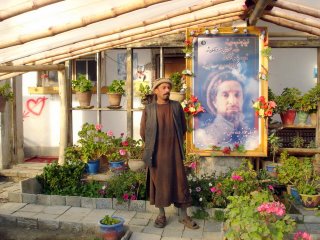 Geraniums and Guns
Geraniums and GunsIt was my one day out of Kabul during my first trip there; my hosts wanted me to see a little of the countryside. So we piled a bunch of people in a van and headed out. The traffic and dust and commercial activity dwindled little by little-- after twenty minutes or so, there were just a few melon stands on the side of the road and a gas station (erroneously labeled, in English, Pimp Station). There was some dispute at the front of the van about which road to take, then we finally turned up one that was crowded, at the end, with small signs announcing various NGO-type programs at work in the area.
At the top of the mountain, we turned off the main road and headed down a tree-lined avenue to an old wrecked building. I was either never clear to begin with--or have forgotten-- if the place was one of the king's minor palaces or a warlord estate; whatever, it had been thoroughly bombed at some stage of the wars. It was now a park of sorts-- there were some gardens (although ragged and bare, because it was December) and a few intact rooms to creep through and a huge veranda for viewing the wide vista of fields and mud-brick houses below.
Some men were standing on top of the wrecked building when we pulled up. They grinned and waved their machine guns at us, much as someone would welcome you to a party with upheld wine glasses, the gesture meant to imply, "Come, come! We've been looking out for you!" So we waved at the guys and parked the van and headed toward the house, then saw this greenhouse made of poplar sticks and plastic sheeting in the rubble. The gardener--he in the brown robes--was eager for us to admire his work. I don't think there was anything edible growing there. It was all pink flowers of one kind or another, a love garden for Ahmed Shah Massoud. He is the man in the portrait, the Tajik fighter credited (by some, depending on their own ethnic identity) as being the Taliban's fiercest scourge, the one who was murdered shortly before 9/11. His portrait hangs all over Kabul, but I never saw it so tenderly displayed as in this setting with the pink flowers and the heart painted on the wall.
I remembered this photo when I was having dinner with friends a few days ago and we were talking about the TV special about the buildup to 9/11. One of the friends said, "That Massoud -- what a hottie!"
Well, yes.

Friday, September 08, 2006
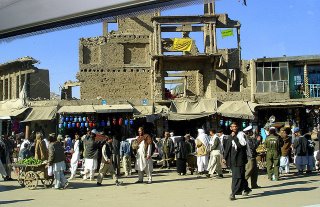 The Morning Death Count
The Morning Death CountI have a dual-alarm clock set to go off every morning at 5:30 (husband) and 6:00 (me). It's set to our local NPR station because music might not wake us up, the alarm itself is too shrill, and I like the NPR host voices-- they're among my favorite and most familiar voices anywhere. Sometimes I'm tempted to change the station when I wake to news of yet another suicide bomber in Iraq or more signs of global-warming --one wonders if it's worth getting out of bed. Still, the company of those calm, intelligent voices gives me some hope, even when the news doesn't.
This morning, my husband lay there listening when his alarm went off. Then he said, "They're talking about Afghanistan." So I had to lift my head and pay attention: a car bomb outside the US embassy in Kabul, killing (I think) eighteen Afghans and two American soldiers.
I know exactly where it happened. I was dropped off in front of the long blockaded street to the American Embassy there back in April, walked past the soldiers and their machine guns behind piles of sandbags, past the high battered walls that hid the embassy from the streets, past the soldiers from India and Africa who had been recruited to help guard the embassy, past the beefy security guys at the entrance to the building, into the old part of the compound which looks like a really really tidy trailer park. I have notes on all this somewhere, because it felt so thrilling to be there--me, old radical and vehement Bushaphobe, inside the heart of the American engagement. It was only a social call with Debbie Rodriguez, an American hairdresser who lives in Kabul and who was showing me around while I was there to help her write her book, Kabul Beauty School. It was thrilling to be there because it made me feel as if I were in the middle of a different kind of drama than the one outside the compound. I kept wondering if the guy playing basketball or the woman reading in the sun were CIA, if they were involved in some kind of superpower subterfuge that was subtly shifting future events. I'm a hick from Cleveland, not used to consorting with the mighty.
Outside, on the streets of Kabul, there was no need for imagination. There was no time for imagination-- all was hustle, move quickly or get hit by that guy on the bicycle, don't step in the sewer or in that pile of camel dung, cover your head! People have asked me over and over again what it was like to be in Afghanistan, and over and over I am speechless. So many people and their beasts and vehicles and wares clogging the streets, amid buildings that are going up and buildings that are falling down. I was always speechless as Debbie and I drove around, too--so much to see and no time to reflect.
There's a reason that I chose the picture at the top of this post and not any of the 200 others I have from my trips to Kabul (aside from the fact that I don't know how to post more than one picture at a time). I love this picture because it shows how Afghans have hurled themselves back into business after three decades of war. That building in the background had been bombed at some point-- by the Russians? the mujahadeen? the Taliban? the US? Don't know, but the fact that it's unreconstructed didn't deter the Afghans. You can see that at the very top, there are only a few teetering piles of brick left. Someone draped a flag or maybe a makeshift business sign on the floor below it. The next floor has been conscripted for storage. Bottom floor: open for business, despite all those creeky ruins above! Crowded with people and products and conversation and argument and life.
This is what's so depressing about the latest news from Afghanistan. There is not only heightened fighting in the south, but also--violence is starting to become ordinary in Kabul. When I was there, I saw people working hard to get things started again-- little businesses opening everywhere, new buildings going up, fresh coats of paint. All sorts of people who didn't have to live through the misery of the wars are there, too--foreigners or Afghans who fled--coming to open businesses or start nonprofits. People in Kabul tell me by email that they think the violence is caused by militants from Pakistan who are sneaking in with the bombs and rockets. Afghans aren't doing it, they say-- Afghans just want to get a life again. When I listened to the report about the car bomb, I wondered if they'll get that chance.
I still want to go back to Kabul in November--there, I've said it. We only get the headlines here in the states about the bombs and the rockets and the riots, but there are other stories of ordinary people carrying on in their own remarkable ways there. I already wrote one article about them for Entrepreneur Magazine, another for Gourmet. There are plenty of other stories, and I want to write at least some of them.

Sunday, September 03, 2006
Honoring the Ordinary
I remember the first time I read about blogging in the New Yorker and wondered why anyone would want to write or read one. I even felt that way a few months ago, before friends talked me into trying it myself. By that time, I liked reading their blogs but the idea of writing one myself seemed so onerous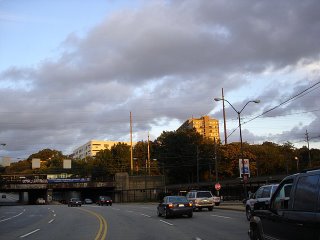 ...all that extra work to send words flying into space, with no one out there to catch them.
...all that extra work to send words flying into space, with no one out there to catch them.
Every paper or magazine I pick up these days seems to carry some beef about blogs. They're mostly concerned with blogs that report or hold forth about the news. They would probably dimiss a blog like mine as tedious navel-gazing.
But I'm not navel gazing (after two children?perish the thought!). I'm observing the world around me little bits at a time and musing out loud about it, and this is what I like about the vast blog jungle. It's full of other ordinary observers and musers and people who don't want to let life slip by without charting it. When you stumble upon a blogger whose voice you like, that person will lead you to others and so on. I feel like a monkey swinging from one marvelous tree to another.
Or switching metaphors, as if I'm moving among galaxies. I flit from lit blogs to gardening blogs to farming blogs to cooking blogs to blogs about Afghanistan, each time leaving one cluster of voices for another. Constellations that wax and wane around a shared passion.
I was going to try for another metaphor about synapses in the brain, but three is too many for one post. Isn't that a great picture of the drive up Cedar Hill at 7:55 on a Sunday night, after spending the day on the shores of the great, raucus lake and eating too much cake?
I remember the first time I read about blogging in the New Yorker and wondered why anyone would want to write or read one. I even felt that way a few months ago, before friends talked me into trying it myself. By that time, I liked reading their blogs but the idea of writing one myself seemed so onerous
 ...all that extra work to send words flying into space, with no one out there to catch them.
...all that extra work to send words flying into space, with no one out there to catch them.Every paper or magazine I pick up these days seems to carry some beef about blogs. They're mostly concerned with blogs that report or hold forth about the news. They would probably dimiss a blog like mine as tedious navel-gazing.
But I'm not navel gazing (after two children?perish the thought!). I'm observing the world around me little bits at a time and musing out loud about it, and this is what I like about the vast blog jungle. It's full of other ordinary observers and musers and people who don't want to let life slip by without charting it. When you stumble upon a blogger whose voice you like, that person will lead you to others and so on. I feel like a monkey swinging from one marvelous tree to another.
Or switching metaphors, as if I'm moving among galaxies. I flit from lit blogs to gardening blogs to farming blogs to cooking blogs to blogs about Afghanistan, each time leaving one cluster of voices for another. Constellations that wax and wane around a shared passion.
I was going to try for another metaphor about synapses in the brain, but three is too many for one post. Isn't that a great picture of the drive up Cedar Hill at 7:55 on a Sunday night, after spending the day on the shores of the great, raucus lake and eating too much cake?

